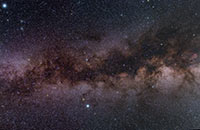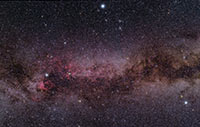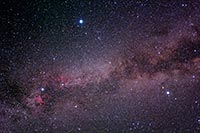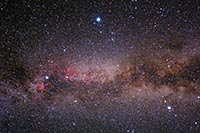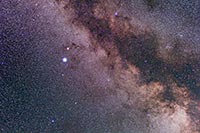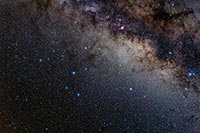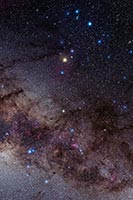Milky Way Wide Angle Photo Gallery
The Milky Way is a hazy band of light that encircles the night sky. To the ancients it looked like milk had been spilled across the heavens which is why the Greeks called it the galaxies kuklos or milky circle. Greek philosophers Anaxagoras (ca. 500–428 BC) and Democritus (450–370 BC) believed the Milky Way consisted of distant stars. Galileo proven them right in 1610 when he turned his simple telescope skyward and discovered the Milky Way was composed of a countless faint stars.
In the 1750s, Immanuel Kant speculated that the Milky Way was an enormous system of stars held together by gravity and rotating about a common center. From our perspective inside the Milky Way, the resulting disk of stars would be seen as a band of light arching across the sky. Kant even suggested that some of the nebulae visible in astronomer's telescopes are distant, separate star systems themselves, similar to the Milky Way and he called them "island universes".
It wasn't until the 1920s that Edwin Hubble conclusively demonstrated that the Milky Way was actually a "spiral nebula" or galaxy (from the Greek galaxies kuklos) resembling the Great Andromeda Galaxy (M31). The major difference is that our own Solar System resides within the Milky Way Galaxy. This gravitationally bound spiral disk of some 100 billion stars has a diameter of 100,000 light years and a thickness of 10,000 light years. The gas, dust and stars in the Milky Way Galaxy are organized in a bar-shaped core surrounded by a disk of curved arms that follow logarithmic spirals like a nautilus shell. These spiral arm structures are easy to see in external galaxies like the Whirlpool Galaxy (M51).
The artificial lights and resulting light pollution of modern cities makes it impossible to see the Milky Way from metropolitan areas. But travel to a remote area with truly dark skies and the Milky Way is revealed as an amazing band of light running across the sky through some of the brightest constellations (e.g. - Taurus, Orion, Carina, Crux, Scorpius, Sagittarius, Aquila, Cygnus, Cassiopeia).
Below is a selection of wide angle images of the Milky Way taken from the dark skies of Portal, AZ.
Milky Way Wide Angle Mosaics
Milky Way - Extreme Wide Angle
Milky Way - Wide Angle
Milky Way Through Constellations
Milky Way Photo Galleries
-
For more photographs of the Milky Way, please visit the following galleries:


